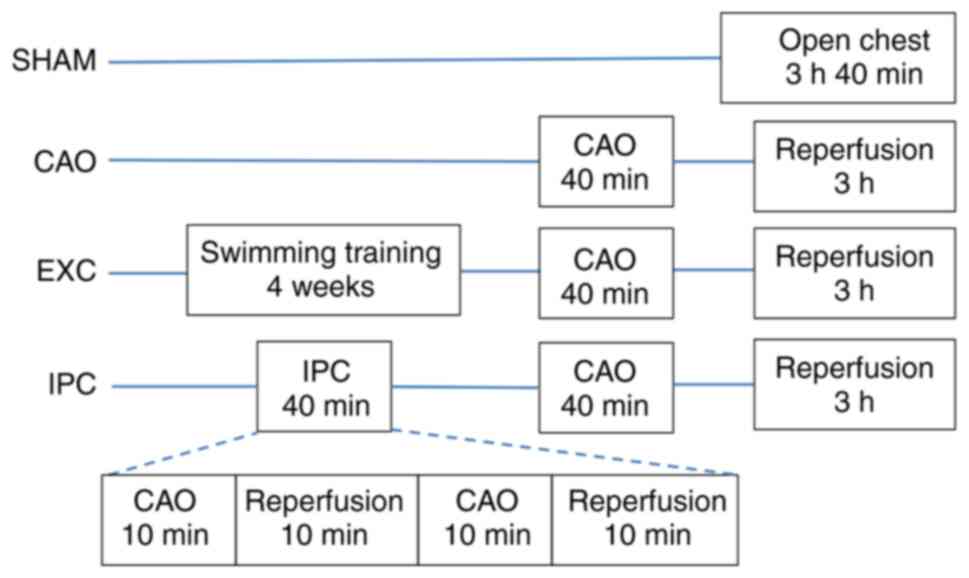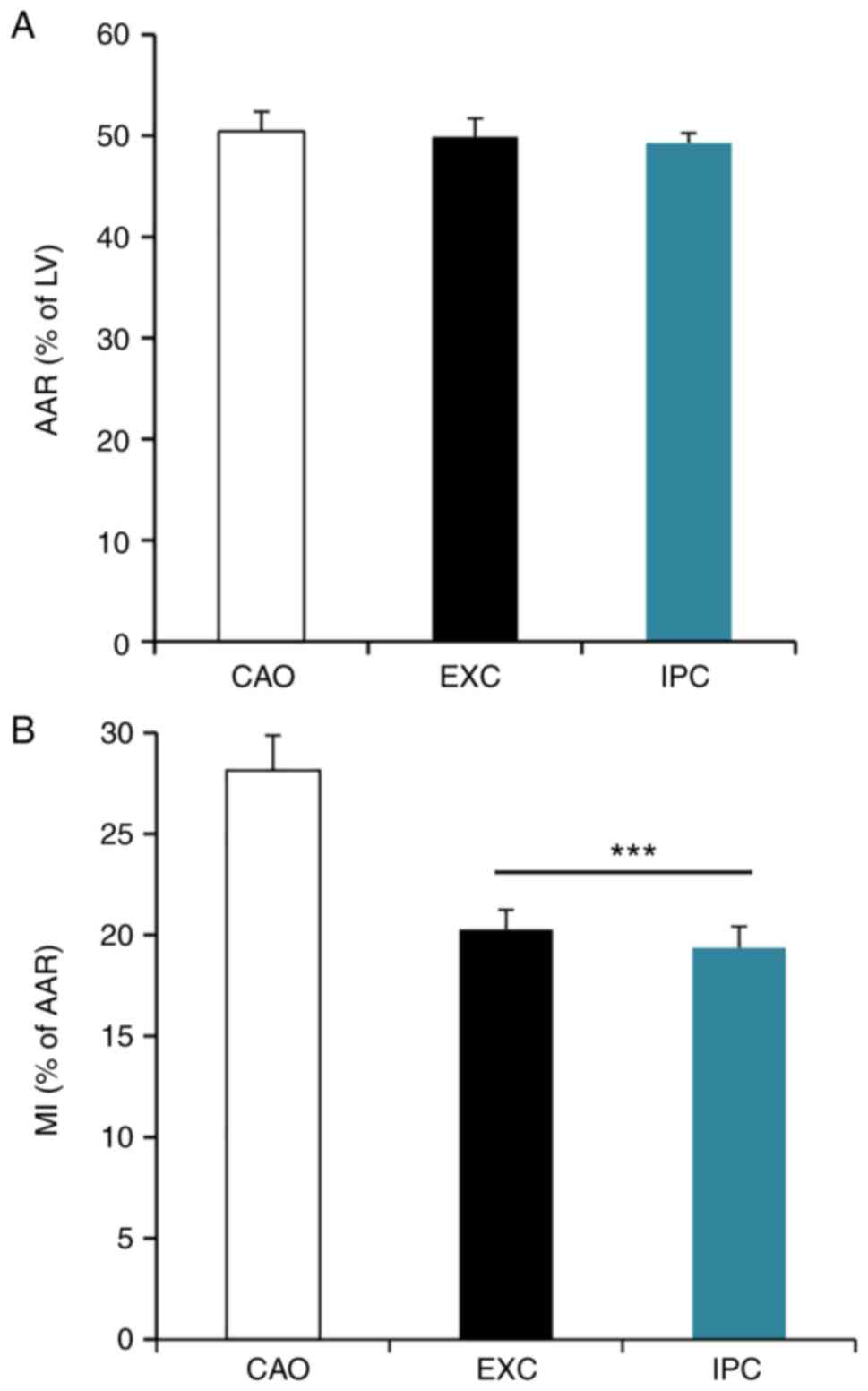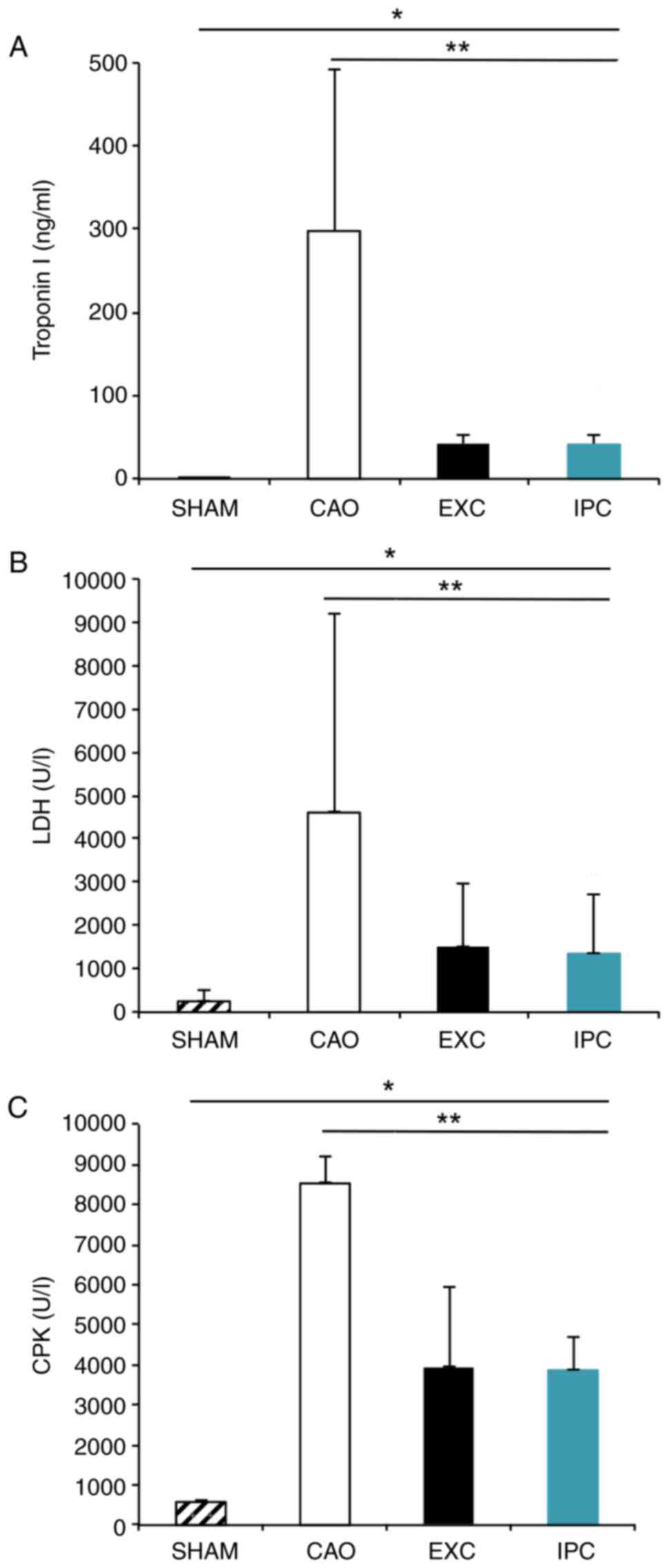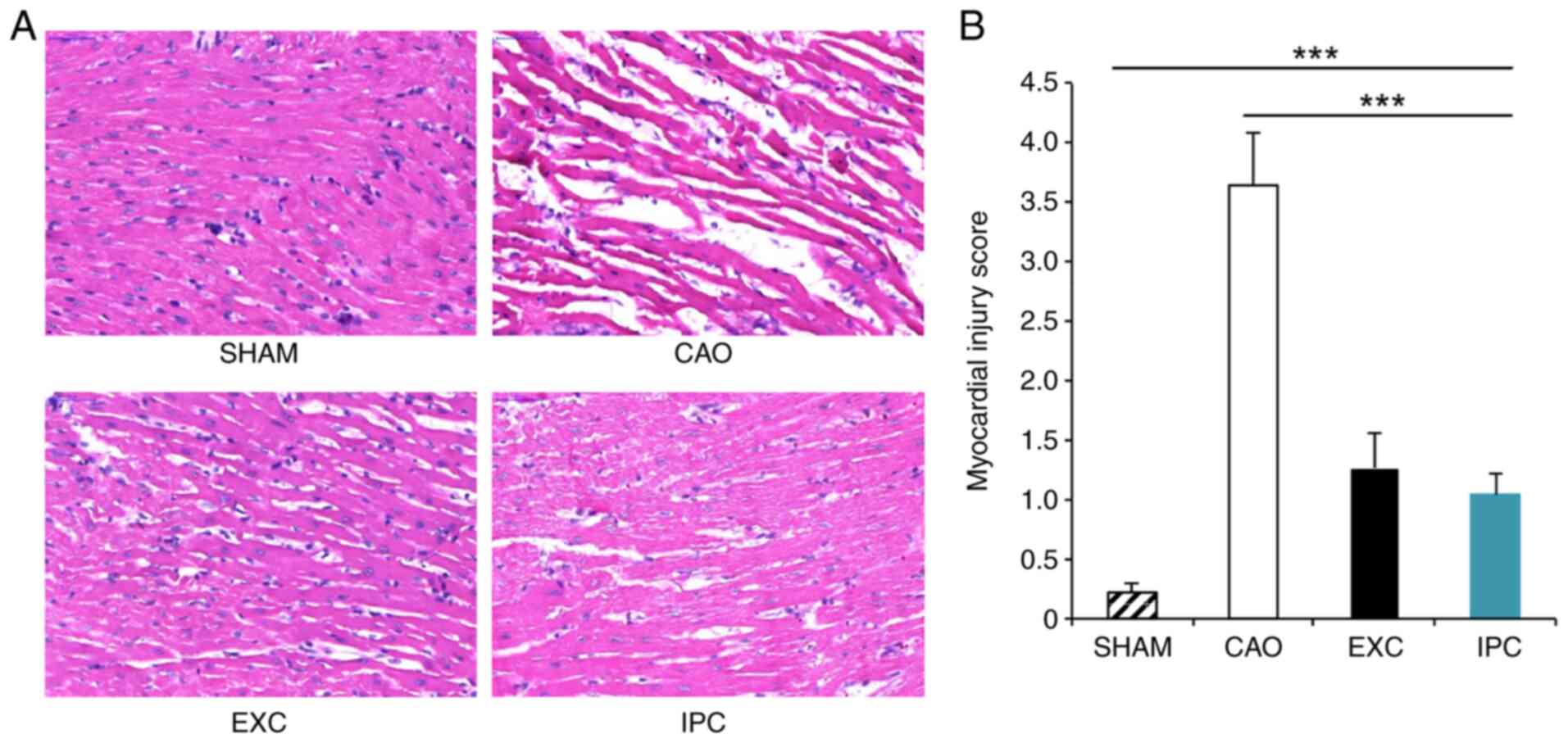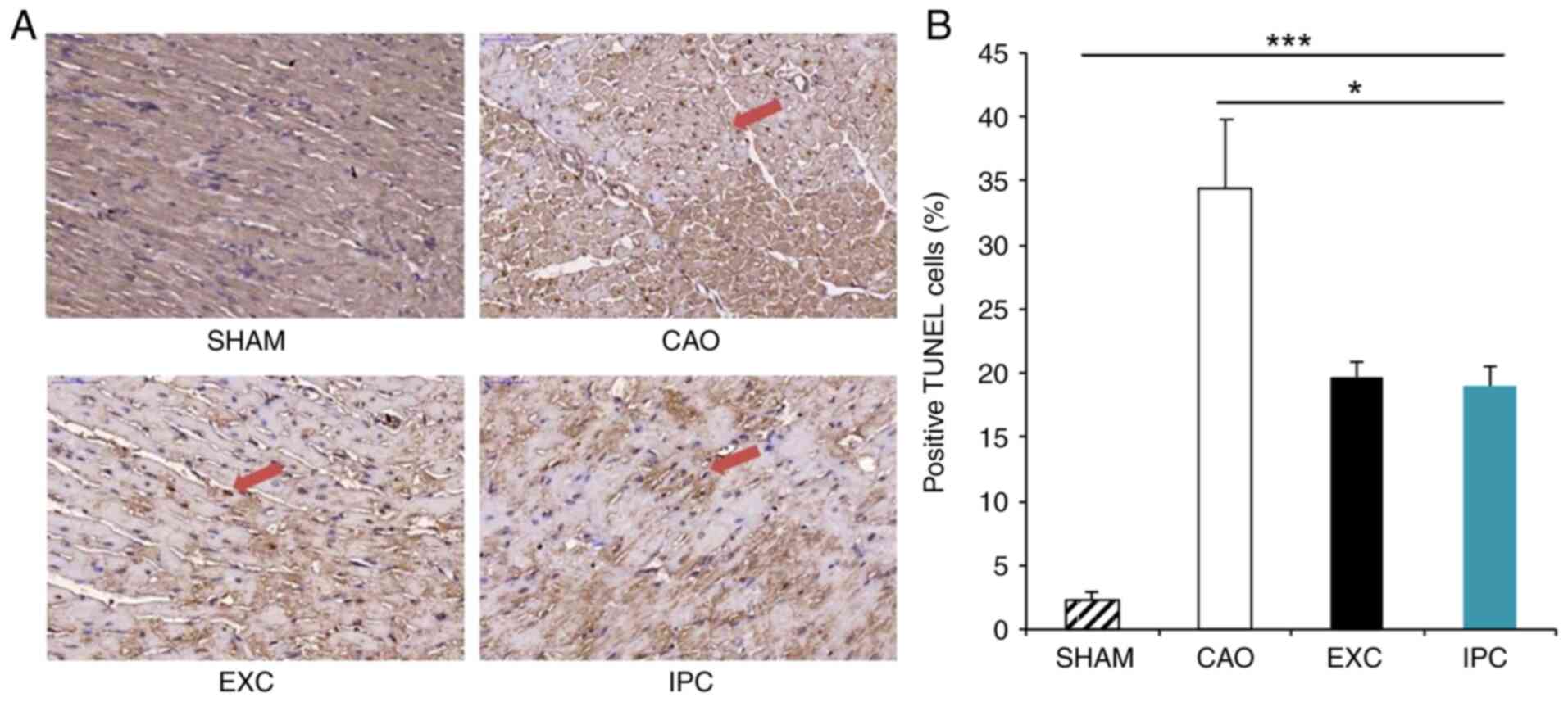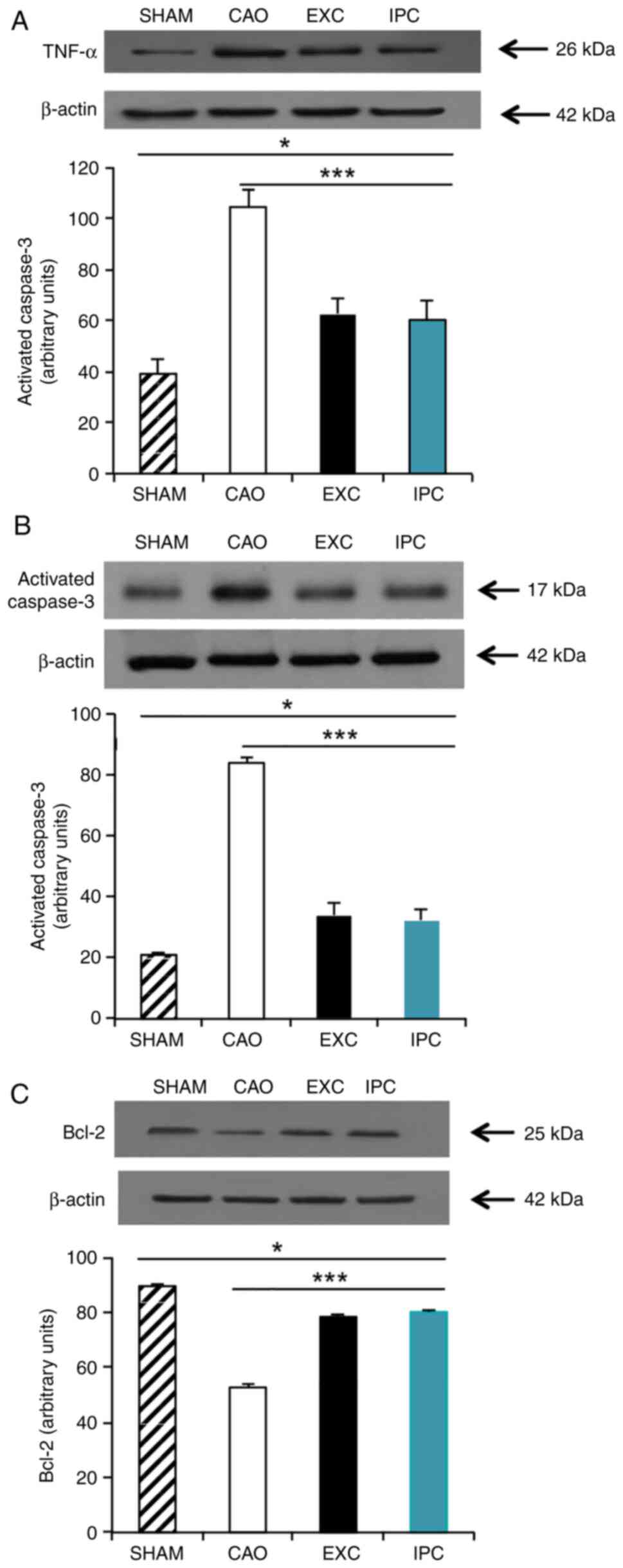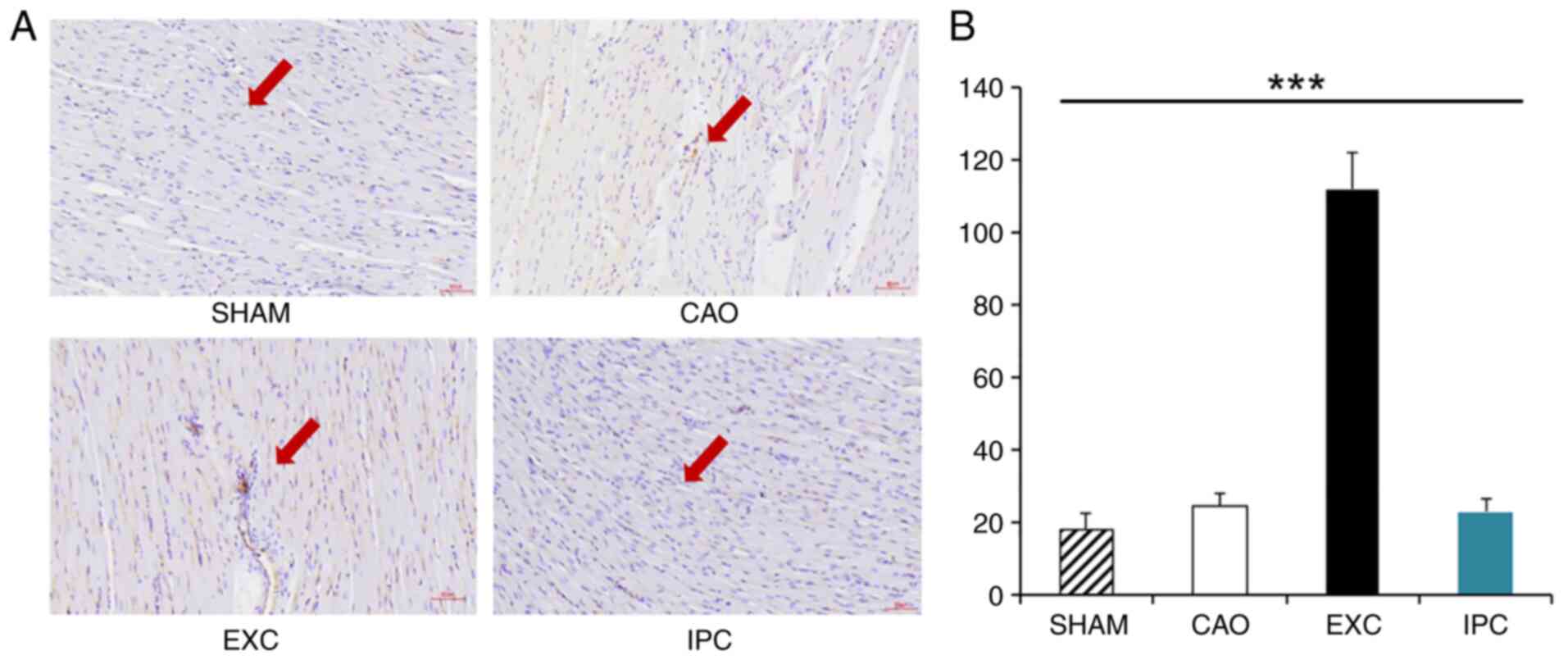|
1
|
Balakumar P, Maung UK and Jagadeesh G:
Prevalence and prevention of cardiovascular disease and diabetes
mellitus. Pharmacol Res. 113:600–609. 2016.PubMed/NCBI View Article : Google Scholar
|
|
2
|
Nowbar AN, Gitto M, Howard JP, Francis DP
and Al-Lamee R: Mortality from ischemic heart disease. Circ
Cardiovasc Qual Outcomes. 12(e005375)2019.PubMed/NCBI View Article : Google Scholar
|
|
3
|
Patterson SW and Starling EH: On the
mechanical factors which determine the output of the ventricles. J
Physiol. 48:357–379. 1914.PubMed/NCBI View Article : Google Scholar
|
|
4
|
Buja LM: Myocardial ischemia and
reperfusion injury. Cardiovasc Pathol. 14:170–175. 2005.PubMed/NCBI View Article : Google Scholar
|
|
5
|
Singhal AK, Symons JD, Boudina S, Jaishy B
and Shiu YT: Role of endothelial cells in myocardial
ischemia-reperfusion injury. Vasc Dis Prev. 7:1–14. 2010.PubMed/NCBI View Article : Google Scholar
|
|
6
|
Sheehan FH, Doerr R, Schmidt WG, Bolson
EL, Uebis R, von Essen R, Effert S and Dodge HT: Early recovery of
left ventricular function after thrombolytic therapy for acute
myocardial infarction: An important determinant of survival. J Am
Coll Cardiol. 12:289–300. 1988.PubMed/NCBI View Article : Google Scholar
|
|
7
|
Reeve JL, Duffy AM, O'Brien T and Samali
A: Don't lose heart-therapeutic value of apoptosis prevention in
the treatment of cardiovascular disease. J Cell Mol Med. 9:609–622.
2005.PubMed/NCBI View Article : Google Scholar
|
|
8
|
Bolli R and Marbán E: Molecular and
cellular mechanisms of myocardial stunning. Physiol Rev.
79:609–634. 1999.PubMed/NCBI View Article : Google Scholar
|
|
9
|
Basso C and Thiene G: The pathophysiology
of myocardial reperfusion: A pathologist's perspective. Heart.
92:1559–1562. 2006.PubMed/NCBI View Article : Google Scholar
|
|
10
|
Ruiz-Meana M, Abellán A, Miró-Casas E and
Garcia-Dorado D: Opening of mitochondrial permeability transition
pore induces hypercontracture in Ca2+ overloaded cardiac
myocytes. Basic Res Cardiol. 102:542–552. 2007.PubMed/NCBI View Article : Google Scholar
|
|
11
|
Argaud L, Loufouat J, Gateau-Roesch O,
Gomez L, Robert D and Ovize M: Persistent inhibition of
mitochondrial permeability transition by preconditioning during the
first hours of reperfusion. Shock. 30:552–556. 2008.PubMed/NCBI View Article : Google Scholar
|
|
12
|
Ishida T, Yarimizu K, Gute DC and Korthuis
RJ: Mechanisms of ischemic preconditioning. Shock. 8:86–94.
1997.PubMed/NCBI View Article : Google Scholar
|
|
13
|
Gross ER and Gross GJ: Ischemic
preconditioning and myocardial infarction: An update and
perspective. Drug Discov Today Dis Mech. 4:165–174. 2007.PubMed/NCBI View Article : Google Scholar
|
|
14
|
Murry CE, Jennings RB and Reimer KA:
Preconditioning with ischemia: A delay of lethal cell injury in
ischemic myocardium. Circulation. 74:1124–1136. 1986.PubMed/NCBI View Article : Google Scholar
|
|
15
|
Vegh A, Szekeres L and Parratt JR:
Transient ischaemia induced by rapid cardiac pacing results in
myocardial preconditioning. Cardiovasc Res. 25:1051–1053.
1991.PubMed/NCBI View Article : Google Scholar
|
|
16
|
Cumming DV, Heads RJ, Brand NJ, Yellon DM
and Latchman DS: The ability of heat stress and metabolic
preconditioning to protect primary rat cardiac myocytes. Basic Res
Cardiol. 91:79–85. 1996.PubMed/NCBI View Article : Google Scholar
|
|
17
|
Huang CH, Kim SJ, Ghaleh B, Kudej RK, Shen
YT, Bishop SP and Vatner SF: An adenosine agonist and
preconditioning shift the distribution of myocardial blood flow in
conscious pigs. Am J Physiol. 276:H368–H375. 1999.PubMed/NCBI View Article : Google Scholar
|
|
18
|
Schott RJ, Rohmann S, Braun ER and Schaper
W: Ischemic preconditioning reduces infarct size in swine
myocardium. Circ Res. 66:1133–1142. 1990.PubMed/NCBI View Article : Google Scholar
|
|
19
|
Liu GS, Thornton J, Van Winkle DM, Stanley
AW, Olsson RA and Downey JM: Protection against infarction afforded
by preconditioning is mediated by A1 adenosine receptors in rabbit
heart. Circulation. 84:350–356. 1991.PubMed/NCBI View Article : Google Scholar
|
|
20
|
Li Y and Kloner RA: The cardioprotective
effects of ischemic ‘preconditioning’ are not mediated by adenosine
receptors in rat hearts. Circulation. 87:1642–1648. 1993.PubMed/NCBI View Article : Google Scholar
|
|
21
|
Sumeray MS and Yellon DM: Ischaemic
preconditioning reduces infarct size following global ischaemia in
the murine myocardium. Basic Res Cardiol. 93:384–390.
1998.PubMed/NCBI View Article : Google Scholar
|
|
22
|
Wilmore JH: Aerobic exercise and
endurance: Improving fitness for health benefits. Phys Sportsmed.
31:45–51. 2003.PubMed/NCBI View Article : Google Scholar
|
|
23
|
Swain DP and Franklin BA: Comparison of
cardioprotective benefits of vigorous versus moderate intensity
aerobic exercise. Am J Cardiol. 97:141–147. 2006.PubMed/NCBI View Article : Google Scholar
|
|
24
|
Khot UN, Khot MB, Bajzer CT, Sapp SK,
Ohman EM, Brener SJ, Ellis SG, Lincoff AM and Topol EJ: Prevalence
of conventional risk factors in patients with coronary heart
disease. JAMA. 290:898–904. 2003.PubMed/NCBI View Article : Google Scholar
|
|
25
|
Lawson WE, Hui JC, Zheng ZS, Burgen L,
Jiang L, Lillis O, Oster Z, Soroff H and Cohn P: Improved exercise
tolerance following enhanced external counterpulsation: cardiac or
peripheral effect? Cardiology. 87:271–275. 1996.PubMed/NCBI View Article : Google Scholar
|
|
26
|
Demirel HA, Powers SK, Zergeroglu MA,
Shanely RA, Hamilton K, Coombes J and Naito H: Short-term exercise
improves myocardial tolerance to in vivo ischemia-reperfusion in
the rat. J Appl Physiol (1985). 91:2205–2212. 2001.PubMed/NCBI View Article : Google Scholar
|
|
27
|
Perrault H and Turcotte RA:
Exercise-induced cardiac hypertrophy. Fact or fallacy? Sports Med.
17:288–308. 1994.PubMed/NCBI View Article : Google Scholar
|
|
28
|
Jin H, Yang R, Li W, Lu H, Ryan AM,
Ogasawara AK, Van Peborgh J and Paoni NF: Effects of exercise
training on cardiac function, gene expression, and apoptosis in
rats. Am J Physiol Heart Circ Physiol. 279:H2994–H3002.
2000.PubMed/NCBI View Article : Google Scholar
|
|
29
|
McElroy CL, Gissen SA and Fishbein MC:
Exercise-induced reduction in myocardial infarct size after
coronary artery occlusion in the rat. Circulation. 57:958–962.
1978.PubMed/NCBI View Article : Google Scholar
|
|
30
|
Bowles DK, Farrar RP and Starnes JW:
Exercise training improves cardiac function after ischemia in the
isolated, working rat heart. Am J Physiol. 263:H804–H809.
1992.PubMed/NCBI View Article : Google Scholar
|
|
31
|
Gul M, Demircan B, Taysi S, Oztasan N,
Gumustekin K, Siktar E, Polat MF, Akar S, Akcay F and Dane S:
Effects of endurance training and acute exhaustive exercise on
antioxidant defense mechanisms in rat heart. Comp Biochem Physiol A
Mol Integr Physiol. 143:239–245. 2006.PubMed/NCBI View Article : Google Scholar
|
|
32
|
Freimann S, Scheinowitz M, Yekutieli D,
Feinberg MS, Eldar M and Kessler-Icekson G: Prior exercise training
improves the outcome of acute myocardial infarction in the rat:
Heart structure, function, and gene expression. J Am Coll Cardiol.
45:931–938. 2005.PubMed/NCBI View Article : Google Scholar
|
|
33
|
Ozturk N, Olgar Y, Er H, Kucuk M and
Ozdemir S: Swimming exercise reverses aging-related contractile
abnormalities of female heart by improving structural alterations.
Cardiol J. 24:85–93. 2017.PubMed/NCBI View Article : Google Scholar
|
|
34
|
Nagaraja HS and Jeganathan PS: Forced
swimming stress-induced changes in the physiological and
biochemical parameters in albino rats. Indian J Physiol Pharmacol.
43:53–59. 1999.PubMed/NCBI
|
|
35
|
Popgeorgiev N, Sa JD, Jabbour L, Banjara
S, Nguyen TTM, Akhavan-E-Sabet A, Gadet R, Ralchev N, Manon S,
Hinds MG, et al: Ancient and conserved functional interplay between
Bcl-2 family proteins in the mitochondrial pathway of apoptosis.
Sci Adv. 6(eabc4149)2020.PubMed/NCBI View Article : Google Scholar
|
|
36
|
Chou PL, Chen KH, Chang TC and Chien CT:
Repetitively hypoxic preconditioning attenuates
ischemia/reperfusion-induced liver dysfunction through upregulation
of hypoxia-induced factor-1 alpha-dependent mitochondrial Bcl-xl in
rat. Chin J Physiol. 63:68–76. 2020.PubMed/NCBI View Article : Google Scholar
|
|
37
|
Murphy MP and Hartley RC: Mitochondria as
a therapeutic target for common pathologies. Nat Rev Drug Discov.
17:865–886. 2018.PubMed/NCBI View Article : Google Scholar
|
|
38
|
Jiang T, Ma X, Chen H, Jia H and Xiong Y:
Diazepam ameliorated myocardial ischemia-reperfusion injury via
inhibition of C-C chemokine receptor type 2/Tumor necrosis
factor-alpha/Interleukins and Bcl-2-associated X protein/Caspase-3
pathways in experimental rats. J Vet Med Sci. 83:1965–1976.
2021.PubMed/NCBI View Article : Google Scholar
|
|
39
|
Verboven M, Cuypers A, Deluyker D,
Lambrichts I, Eijnde BO, Hansen D and Bito V: High intensity
training improves cardiac function in healthy rats. Sci Rep.
9(5612)2019.PubMed/NCBI View Article : Google Scholar
|
|
40
|
Clark JD, Gebhart GF, Gonder JC, Keeling
ME and Kohn DF: The 1996 guide for the care and use of laboratory
animals. ILAR Journal. 38:41–48. 1997.PubMed/NCBI View Article : Google Scholar
|
|
41
|
Gazdag P, Oravecz K, Acsai K,
Demeter-Haludka V, Ördög B, Szlovák J, Kohajda Z, Polyák A, Barta
BA, Oláh A, et al: Increased Ca2+ content of the
sarcoplasmic reticulum provides arrhythmogenic trigger source in
swimming-induced rat athlete's heart model. Sci Rep.
10(19596)2020.PubMed/NCBI View Article : Google Scholar
|
|
42
|
Lee HW, Han TH, Yi KJ, Choi MC, Lee SY and
Ryu PD: Time course of diurnal rhythm disturbances in autonomic
function of rats with myocardial infarction. Auton Neurosci.
179:28–36. 2013.PubMed/NCBI View Article : Google Scholar
|
|
43
|
Zhao C, Yin M, Li F, Ling W, Luo C and Qin
S: Mechanisms of Paeoniflorin against myocardial ischemia
reperfusion injury based on network pharmacology. Mater Exp.
11:1505–1515. 2021.
|
|
44
|
El-Shitany NA, Tolba OA, El-Shanshory MR
and El-Hawary EE: Protective effect of carvedilol on
adriamycin-induced left ventricular dysfunction in children with
acute lymphoblastic leukemia. J Card Fail. 18:607–613.
2012.PubMed/NCBI View Article : Google Scholar
|
|
45
|
Sabatasso S, Mangin P, Fracasso T, Moretti
M, Docquier M and Djonov V: Early markers for myocardial ischemia
and sudden cardiac death. Int J Legal Med. 130:1265–1280.
2016.PubMed/NCBI View Article : Google Scholar
|
|
46
|
Thornberry NA and Lazebnik Y: Caspases:
Enemies within. Science. 281:1312–1316. 1998.PubMed/NCBI View Article : Google Scholar
|
|
47
|
Guski H, Meerson FZ and Wassilew G:
Comparative study of ultrastructure and function of the rat heart
hypertrophied by exercise or hypoxia. Exp Pathol. 20:108–120.
1981.PubMed/NCBI View Article : Google Scholar
|
|
48
|
Yellon DM and Hausenloy DJ: Myocardial
reperfusion injury. N Engl J Med. 357:1121–1135. 2007.PubMed/NCBI View Article : Google Scholar
|
|
49
|
Frank A, Bonney M, Bonney S, Weitzel L,
Koeppen M and Eckle T: Myocardial ischemia reperfusion injury: From
basic science to clinical bedside. Semin Cardiothorac Vasc Anesth.
16:123–132. 2012.PubMed/NCBI View Article : Google Scholar
|
|
50
|
Pluijmert NJ, Bart CI, Bax WH, Quax PH and
Atsma DE: Effects on cardiac function, remodeling and inflammation
following myocardial ischemia-reperfusion injury or unreperfused
myocardial infarction in hypercholesterolemic APOE*
3-Leiden mice. Sci Rep. 10(16601)2020.PubMed/NCBI View Article : Google Scholar
|
|
51
|
Hong XY, Hong X, Gu WW, Lin J and Yin WT:
Cardioprotection and improvement in endothelial-dependent
vasodilation during late-phase of whole body hypoxic
preconditioning in spontaneously hypertensive rats via VEGF and
endothelin-1. Eur J Pharmacol. 842:79–88. 2019.PubMed/NCBI View Article : Google Scholar
|
|
52
|
Bolli R: The late phase of
preconditioning. Circ Res. 87:972–983. 2000.PubMed/NCBI View Article : Google Scholar
|
|
53
|
Marini M, Lapalombella R, Margonato V,
Ronchi R, Samaja M, Scapin C, Gorza L, Maraldi T, Carinci P,
Ventura C and Veicsteinas A: Mild exercise training,
cardioprotection and stress genes profile. Eur J Appl Physiol.
99:503–510. 2007.PubMed/NCBI View Article : Google Scholar
|
|
54
|
Labarca G, Gower J, Lamperti L, Dreyse J
and Jorquera J: Chronic intermittent hypoxia in obstructive sleep
apnea: A narrative review from pathophysiological pathways to a
precision clinical approach. Sleep Breath. 24:751–760.
2020.PubMed/NCBI View Article : Google Scholar
|
|
55
|
Sanderson JE, Fang F, Lu M, Ma CY and Wei
YX: Obstructive sleep apnoea, intermittent hypoxia and heart
failure with a preserved ejection fraction. Heart. 107:190–194.
2021.PubMed/NCBI View Article : Google Scholar
|
|
56
|
Nanduri J and Nanduri RP: Cellular
mechanisms associated with intermittent hypoxia. Essays Biochem.
43:91–104. 2007.PubMed/NCBI View Article : Google Scholar
|
|
57
|
Chen L, Shi D and Guo M: The roles of
PKC-delta and PKC-epsilon in myocardial ischemia/reperfusion
injury. Pharmacol Res. 170(105716)2021.PubMed/NCBI View Article : Google Scholar
|
|
58
|
Radak Z, Chung HY and Goto S: Systemic
adaptation to oxidative challenge induced by regular exercise. Free
Radic Biol Med. 44:153–159. 2008.PubMed/NCBI View Article : Google Scholar
|
|
59
|
Powers SK, Deminice R, Ozdemir M,
Yoshihara T, Bomkamp MP and Hyatt H: Exercise-induced oxidative
stress: Friend or foe? J Sport Health Sci. 9:415–425.
2020.PubMed/NCBI View Article : Google Scholar
|
|
60
|
Soukhova-O'Hare GK, Ortines RV, Gu Y,
Nozdrachev AD, Prabhu SD and Gozal D: Postnatal intermittent
hypoxia and developmental programming of hypertension in
spontaneously hypertensive rats: The role of reactive oxygen
species and L-Ca2+ channels. Hypertension. 52:156–162.
2008.PubMed/NCBI View Article : Google Scholar
|
|
61
|
Boulghobra D, Coste F, Geny B and Reboul
C: Exercise training protects the heart against
ischemia-reperfusion injury: A central role for mitochondria? Free
Radic Biol Med. 152:395–410. 2020.PubMed/NCBI View Article : Google Scholar
|
|
62
|
Lee MG, Park KS, Kim DU, Choi SM and Kim
HJ: Effects of high-intensity exercise training on body
composition, abdominal fat loss, and cardiorespiratory fitness in
middle-aged Korean females. Appl Physiol Nutr Metab. 37:1019–1027.
2012.PubMed/NCBI View Article : Google Scholar
|
|
63
|
Pattwell DM, McArdle A, Morgan JE,
Patridge TA and Jackson MJ: Release of reactive oxygen and nitrogen
species from contracting skeletal muscle cells. Free Radic Biol
Med. 37:1064–1072. 2004.PubMed/NCBI View Article : Google Scholar
|
|
64
|
McArdle A, van der Meulen J, Close GL,
Pattwell D, Van Remmen H, Huang TT, Richardson AG, Epstein CJ,
Faulkner JA and Jackson MJ: Role of mitochondrial superoxide
dismutase in contraction-induced generation of reactive oxygen
species in skeletal muscle extracellular space. Am J Physiol Cell
Physiol. 286:C1152–C1158. 2004.PubMed/NCBI View Article : Google Scholar
|
|
65
|
Rinaldi B, Corbi G, Boccuti S, Filippelli
W, Rengo G, Leosco D, Rossi F, Filippelli A and Ferrara N: Exercise
training affects age-induced changes in SOD and heat shock protein
expression in rat heart. Exp Gerontol. 41:764–770. 2006.PubMed/NCBI View Article : Google Scholar
|
|
66
|
Dasgupta A, Wu D, Tian L, Xiong PY,
Dunham-Snary KJ, Chen KH, Alizadeh E, Motamed M, Potus F, Hindmarch
CCT and Archer SL: Mitochondria in the pulmonary vasculature in
health and disease: Oxygen-sensing, metabolism, and dynamics. Compr
Physiol. 10:713–765. 2020.PubMed/NCBI View Article : Google Scholar
|
|
67
|
Siu PM, Bryner RW, Martyn JK and Always
SE: Apoptotic adaptations from exercise training in skeletal and
cardiac muscles. FASEB J. 18:1150–1152. 2004.PubMed/NCBI View Article : Google Scholar
|
|
68
|
O'Brien PJ, Smith DE, Knechtel TJ, Marchak
MA, Pruimboom-Brees I, Brees DJ, Spratt DP, Archer FJ, Butler P,
Potter AN, et al: Cardiac troponin I is a sensitive, specific
biomarker of cardiac injury in laboratory animals. Lab Anim.
40:153–171. 2006.PubMed/NCBI
|
|
69
|
Evran B, Karpuzoğlu H, Develi S, Kalaz EB,
Soluk-Tekkeşin M, Olgaç V, Doğru-Abbasoğlu S and Uysal M: Effects
of carnosine on prooxidant-antioxidant status in heart tissue,
plasma and erythrocytes of rats with isoproterenol-induced
myocardial infarction. Pharmacol Rep. 66:81–86. 2014.PubMed/NCBI View Article : Google Scholar
|
|
70
|
Hausenloy DJ, Schulz R, Girao H, Kwak BR,
De Stefani D, Rizzuto R, Bernardi P and Di Lisa F: Mitochondrial
ion channels as targets for cardioprotection. J Cell Mol Med.
24:7102–7114. 2020.PubMed/NCBI View Article : Google Scholar
|
|
71
|
Marcil M, Bourduas K, Ascah A and Burelle
Y: Exercise training induces respiratory substrate-specific
decrease in Ca2+-induced permeability transition pore
opening in heart mitochondria. Am J Physiol Heart Circ Physiol.
290:H1549–H1557. 2006.PubMed/NCBI View Article : Google Scholar
|
|
72
|
Kavazis AN, McClung JM, Hood DA and Powers
SK: Exercise induces a cardiac mitochondrial phenotype that resists
apoptotic stimuli. Am J Physiol Heart Circ Physiol. 294:H928–H935.
2008.PubMed/NCBI View Article : Google Scholar
|
|
73
|
Mnafgui K, Hajji R, Derbali F, Khlif I,
Kraiem F, Ellefi H, Elfeki A, Allouche N and Gharsallah N:
Protective effect of hydroxytyrosol Against cardiac remodeling
after isoproterenol-induced myocardial infarction in rat.
Cardiovasc Toxicol. 16:147–155. 2016.PubMed/NCBI View Article : Google Scholar
|
|
74
|
Leite CF, Lopes CS, Alves AC, Fuzaro CS,
Silva MV, Oliveira LF, Garcia LP, Farnesi TS, Cuba MB, Rocha LB, et
al: Endogenous resident c-kit cardiac stem cells increase in mice
with an exercise-induced, physiologically hypertrophied heart. Stem
Cell Res. 15:151–164. 2015.PubMed/NCBI View Article : Google Scholar
|
|
75
|
Pan C, Yuan Q and Xu F: Progress in
cardiorespiratory ischemia-reperfusion injury. In: Sudden Death. pp
79-92, 2021.
|
|
76
|
Rath PC and Aggarwal BB: TNF-induced
signaling in apoptosis. J Clin Immunol. 19:350–364. 1999.PubMed/NCBI View Article : Google Scholar
|
|
77
|
Cook AD, Lee MC, Saleh R, Khiew HW,
Christensen AD, Achuthan A, Fleetwood AJ, Lacey DC, Smith JE,
Förster I and Hamilton JA: TNF and granulocyte macrophage-colony
stimulating factor interdependence mediates inflammation via CCL17.
JCI Insight. 3(e99249)2018.PubMed/NCBI View Article : Google Scholar
|
|
78
|
Sheikh MS and Huang Y: Death receptor
activation complexes: It takes two to activate TNF receptor 1. Cell
Cycle. 2:550–552. 2003.PubMed/NCBI
|
|
79
|
Balzano T, Arenas YM, Dadsetan S, Forteza
J, Gil-Perotin S, Cubas-Nuñez L, Casanova B, Gracià F,
Varela-Andrés N, Montoliu C, et al: Sustained hyperammonemia
induces TNF-α IN Purkinje neurons by activating the TNFR1-NF-κB
pathway. J Neuroinflammation. 17(70)2020.PubMed/NCBI View Article : Google Scholar
|
|
80
|
Takeshita M, Tani T, Harada S, Hayashi H,
Itoh H, Tajima H, Ohnishi I, Takamura H, Fushida S and Kayahara M:
Role of transcription factors in small intestinal
ischemia-reperfusion injury and tolerance induced by ischemic
preconditioning. Transplant Proc. 42:3406–3413. 2010.PubMed/NCBI View Article : Google Scholar
|
|
81
|
Huldani Pattelongi I, Massi MN, Idris I,
Bukhari A, Widodo ADW, Uinarni H, Carmelita AB, Trisia A, Gunma S,
Prayudhistya BKA and Achmad H: Cortisol, IL-6, TNF Alfa, Leukocytes
and DAMP on Exercise. Sys Rev Pharm. 11:474–485. 2020.
|
|
82
|
Wertz IE: TNFR1-activated NF-κB signal
transduction: Regulation by the ubiquitin/proteasome system. Curr
Opin Chem Biol. 23:71–77. 2014.PubMed/NCBI View Article : Google Scholar
|
|
83
|
Valen G: The basic biology of apoptosis
and its implications for cardiac function and viability. Ann Thorac
Surg. 75:S656–S660. 2003.PubMed/NCBI View Article : Google Scholar
|
|
84
|
Ji HB, Zhai QW, Liu XY and Zheng ZC:
Transcription regulation of bcl-2 gene. Sheng Wu Hua Xue Yu Sheng
Wu Wu Li Xue Bao (Shanghai). 32:95–99. 2000.PubMed/NCBI
|
|
85
|
Yaoita H, Ogawa K, Maehara K and Maruyama
Y: Attenuation of ischemia/reperfusion injury in rats by a caspase
inhibitor. Circulation. 97:276–281. 1998.PubMed/NCBI View Article : Google Scholar
|
|
86
|
Shimamoto A, Matsuo E, Kaneda S, Ito A,
Kawaguchi K and Takao M: Heat shock protein 70 performs as
pharmacological preconditioning to protect against lung ischemia
reperfusion injury through toll-like receptor 4 signaling. J Heart
Lung Transplant. 40(S69)2021.
|
|
87
|
Mitra S, Dasgupta R and Bagchi A: Heat
shock proteins and their associated oxidative stress-induced heart
disease. Modulation of Oxidative Stress in Heart Disease, 215-235,
2019.
|
|
88
|
Shamsi MM, Hassan ZM and Gharakhanlou R:
Exercise-induced chaperokine activity of hsp70: Possible role in
chronic diseases. In: Chaperokine Activity of Heat Shock Proteins.
Springer, Cham, pp193-209, 2019.
|
|
89
|
Milne KJ, Thorp DB, Krause M and Noble EG:
Core temperature is a greater influence Than endogenous
17β-estradiol on the exercise-induced accumulation of myocardial
heat shock protein mRNA. Can J Physiol Pharmacol. 89:855–860.
2011.PubMed/NCBI View Article : Google Scholar
|
|
90
|
Liu X, Zhang C, Zhang C, Li J, Guo W, Yan
D, Yang C, Zhao J, Xia T, Wang Y, et al: Heat shock protein 70
inhibits cardiomyocyte necroptosis through repressing autophagy in
myocardial ischemia/reperfusion injury. In Vitro Cell Dev Biol
Anim. 52:690–698. 2016.PubMed/NCBI View Article : Google Scholar
|
|
91
|
Rani N, Bharti S, Manchanda M, Nag TC, Ray
R, Chauhan SS, Kumari S and Arya DS: Regulation of heat shock
Proteins 27 and 70, p-Akt/p-eNOS and MAPKs by naringin dampens
myocardial injury and dysfunction in vivo after
ischemia/reperfusion. PLoS One. 8(e82577)2013.PubMed/NCBI View Article : Google Scholar
|
|
92
|
Wu J, Chen S, Liu Y, Liu Z, Wang D and
Cheng Y: Therapeutic perspectives of heat shock proteins and their
protein-protein interactions in myocardial infarction. Pharmacol
Res. 160(105162)2020.PubMed/NCBI View Article : Google Scholar
|
|
93
|
Hsu SF, Hsu CC, Cheng BC and Lin CH:
Cathepsin B is involved in the heat shock induced cardiomyocytes
apoptosis as well as the anti-apoptosis effect of HSP-70.
Apoptosis. 19:1571–1580. 2014.PubMed/NCBI View Article : Google Scholar
|















